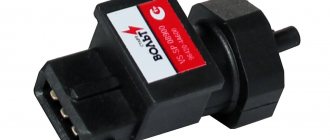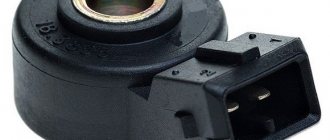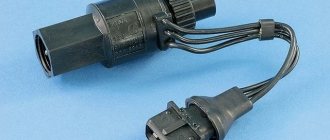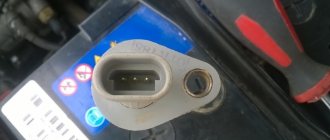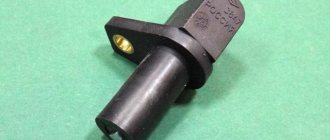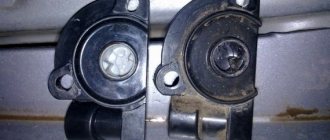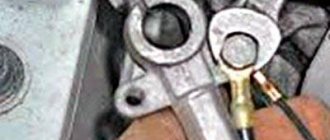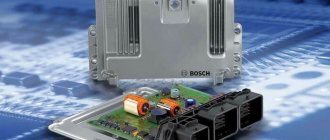Any car is equipped with a system that shows the speed of movement and mileage (distance traveled). It is the speedometer, which is a device for determining instantaneous speed, that makes it possible to find out what the maximum speed of the VAZ 2110 is.
Speed sensors are installed only in fuel-injected cars; where carburetor engines are present, they are not present. This device is responsible for the supply and consumption of fuel, setting the ignition timing, and monitors the quality of the combustible mixture. All data is transmitted to the electronic control unit, which controls the injector.
Before the advent of sensors, mechanical speedometer drives were installed on each carburetor engine. On VAZ 2010 cars produced before 2006, mechanical drives are installed. Newer cars manufactured after 2006 are equipped with electronic sensors.
Speed sensor VAZ 2110 purpose
The VAZ 2110 speed sensor is responsible for the correct fuel supply, “sets” the ignition timing and controls the quality of the combustible mixture.
The sensor “collects” a lot of data for the injector (such as engine speed, speed, detonation level, etc.) and transmits digital signals to the electronic unit. In turn, all data is checked here and appropriate adjustments are made to the operation of the injector.
The principle of operation of the speed meter for the VAZ 2110 injection engine
So, why is the device in question located vertically if the axis of rotation of the manual transmission drive shaft is precisely horizontal? The fact is that the rotating element of the device is connected to the gearbox shaft not directly, but through a transition rotation transformer. Using a worm gear, horizontal rotation with a certain gear ratio is transformed to the mechanical part of the speed sensor.
The shaft end of the electronic part of the sensor, which we can see from the outside of the gearbox, is inserted into the adapter receiving sleeve.
The system operates according to the Hall principle. The moving parts of the Hall elements are located on the shaft inside the housing. When rotating, the counter part (in the form of an inductor) generates pulses synchronous with the rotation of the wheel. Since the circumference of the tire is known, the electronic module converts each revolution into a distance traveled. This is how mileage is calculated. It remains to divide this figure by a unit of time, and we get the speed of the car at any time.
Important! Information for those who like to change their shoes to non-standard tires. By installing tuning wheels and tires with a dimension difference of more than 3%, you do not just create additional load on the suspension elements. The algorithm for calculating the speed of movement is disrupted: the crankshaft, camshaft and speed sensors become desynchronized. As a result, the ECU incorrectly forms the composition of the fuel mixture and makes errors in setting the ignition timing. That is, the sensor does not operate normally (but there is no damage).
Types of speed sensors, their differences. Where is the speed sensor located?
- Electronic 6-pulse sensors are equipped with cars with injection engines, launched into series since 2006.
- On carburetor Samaras you can sometimes find 10-pulse EMF.
Until 2006, VAZ cars used mechanical devices in the form of special inserts between the speed indicator cables and the gearbox gear outputs.
The key difference between different types of EMF is the absence of wires and connecting connectors. For example, GM or Yantar systems are equipped with products with round (oval) ports. At the same time, Bosh uses wireless versions with square connectors.
On the VAZ-2110 (2111, 2112), speed sensors are mounted on the gearbox housings slightly to the right along the route, directly next to the oil control dipstick.
The device is easy to find by looking in the area of the right CV joint.
On the VAZ-2115, the electronic device is mounted on top of the front part of the gearbox (along the way) directly above the differential. The product with the connected cable is secured with one bolt on the box body.
All instruments on the VAZ 10 that indicate the speed of the vehicle are pointers, and signs of a malfunction are determined by deviations from the norm of the speedometer needle. If the speedometer is faulty, the arrow when the car is moving:
- does not deviate from zero, that is, does not show speed at all;
- stuck in one position, does not move in any direction;
- jumps, sharply changing readings, while the displayed speed does not correspond to reality.
There are other signs of a faulty speedometer, for example, the device works on a cold engine, and its readings correspond to the norm. As the engine warms up completely, the needle freezes and stops moving.
The main reason why the speedometer on a VAZ-2110 injector does not work is contamination (oiling) of the speed sensor (DS), failure especially often occurs if oil from the gearbox or engine gets onto the DS (for example, there is a leak from the valve cover of the internal combustion engine ). There are also other reasons:
- the speedometer itself has failed;
- the speed sensor is broken (this part on AvtoVAZ cars is not highly reliable);
- there is no normal contact in the DS plug or a break (short circuit) of the wires has occurred;
- The speedometer drive gears installed in the gearbox broke.
Video.
Schematic electrical diagrams, connecting devices and pinouts of connectors
The speed sensor is an element of the vehicle's electronic control system. It depends on its readings how much fuel will be supplied, how much air will bypass the throttle valve when idling, and what the speedometer readings will be.
The speed sensor of a VAZ car is based on the use of the Hall effect, that is, a stream of pulses is transmitted from the device to the car's ECU, the frequency of which is proportional to the speed of the car. Auto electronics, analyzing incoming data, selects the required idle speed and sends a signal to a device that regulates the engine idle speed, which optimizes the composition of the air-droplet mixture entering the combustion chamber, bypassing the throttle valve.
During a distance of one kilometer, the speed sensor transmits over 6000 pulses to the ECU. Based on the parameters of the time analysis of inter-pulse signals, the on-board computer transmits data to the dashboard, thereby determining the speedometer readings.
As in many other cars, the VAZ speed sensor is located in the upper part of the gearbox housing, not far from the engine oil level dipstick. You can get to it from two sides: from above, by opening the hood and disconnecting the adsorber, and from below, using the inspection hole for convenience.
Signs of a malfunction speed sensor VAZ 2110
Typical signs of a malfunctioning speed sensor on a VAZ 2110 car are as follows:
- unstable operation and incorrect speedometer and odometer readings;
- cessation of stable engine operation at idle;
- errors generated by the computer (P0500 – no sensor signal, P0503 – intermittent sensor signal).
The problems listed above may result from:
- poor contact in the sensor connector due to contamination;
- violation of the integrity of the wiring from the sensor to the ECU;
- mechanical failure of the DS drive (in older VAZ 2110 models).
Speedometer malfunctions VAZ 2110 carburetor
On early 2110 cars with a carburetor, the speedometer needle is driven from the gearbox by a mechanical cable, and it is much easier to determine the cause of the malfunction here than in an electronic circuit. Checking the serviceability of the speedometer cable is simple: it must be disconnected from the gearbox - if the tetrahedron at its end is intact, then everything is in order in this connection.
Next, we take the tip of the cable with our fingers and try to twist it; if there are no breaks in the cable, the speedometer needle should begin to move (rise). If the vehicle rotates too freely with its fingers, the cable is most likely broken. To check the tens mechanical speedometer itself, you need to remove the instrument cluster.
If this option does not help you, look at the knock sensor of the VAZ 2110, this may be the reason.
Causes of malfunction of the speed sensor
The absence of speedometer readings does not mean failure of the device. Although, to buy a speed sensor for a “ten”, it is enough to spend a small amount, but it will be very disappointing that the fact of replacing the speed sensor will not give the desired effect. And the reasons may be the following:
- The presence of dirt, dust and oil smudges on the speed sensor, a video on replacing which can be found on the Internet. They form on the body of the product during vehicle operation. To prevent the product in this case, you just need to clean the device.
- Unstable contact of the product connector and broken wiring.
- Sometimes the defect is of a purely mechanical nature, which consists of banal defects in the cable of the instrument speed indicator - speedometer.
The following options are possible here:
1. Complicated uneven movement of a braided cable, which is caused by cable defects - burrs or ruptures of the metal strands of the cable. They can significantly affect the functionality of the sensor drive. 2. Increased cable speed.
Checking the device for serviceability:
- We hang the front wheel of the vehicle on a jack.
- We disconnect the wire contact from the product and connect a digital multimeter or similar device to it
- Making rotational movements with the hanging wheel at low speed, we measure the pulse flow signal from the connector. The functionality test begins with checking the grounding and power supply of the electrical circuit.
- We remove the device from its seat.
- We connect the device for measuring voltage to the output contacts.
- By turning the speed sensor drive, we measure its potential difference.
- The output should produce data in which, as the rotor speed increases, the frequency and voltage of the output power increases.
The functionality of the device is considered satisfactory if, during diagnostics, it shows the frequency and voltage parameters at the output contact. Otherwise, replacing the speed sensor of the VAZ “Ten” cannot be avoided.
Species features
Modern engines have electronic control units that read sensor information.
The speedometer diagram of any old Kamaz model will show a direct connection. The first option is now the highest priority, because the ability to place the sensor directly in the internal combustion engine provides a greater amount of information about the operation of all vehicle systems. The DSA generates a pulse signal, the frequency of the pulses is proportional to the number of shaft revolutions, respectively, to the speed of movement. Thus, speed measurement is the controller's calculation of the rotation speed per unit of time. A malfunctioning speed sensor is a complex problem. On a modern vehicle, systems that operate completely autonomously are rarely found, so the failure of one inevitably entails a number of problems that need to be quickly resolved. For example, a faulty DSA can trigger the loss of speed data, mileage traveled (speedometers are often structurally linked to odometers), disrupt the operation of the power unit, leading to unstable idling, increased fuel consumption, loss of power, and unstable operation of the power steering.
Sensors are subject to mandatory replacement, and it is necessary to install exactly the model that was installed previously, or a similar one recommended by the manufacturer. Installing cheap Chinese analogues is a very risky business, threatening data loss and further breakdowns of other associated systems. A non-native DSA may simply not “stand up” correctly, or during the testing phase it may produce incorrect data.
Kamaz contact sensors are less reliable due to the interaction of several spare parts. However, it is precisely such components that are installed most often, replacing a mechanical speedometer or upgrading the brake system. Sometimes, instead of contact units, drive disks or rotors are used - non-contact models. Modern Kamaz trucks are equipped with them.
- Contact sensors are a microcircuit with a special plate, an amplifying circuit. Small magnet connectors allow you to read instrument readings. This principle was installed on the old Kamaz 5320 model.
- Non-contact models operate on the Hall effect (a system of frequency pulses delivered at certain intervals). The wheels rotate, generating a certain pulse amplitude. The mechanics calculate the indicators, displaying the data on the dashboard. Typically the calculation is based on six thousand signals per kilometer traveled. The most complex and accurate is considered to be the Euro DSA, borrowed from foreign trucks. The structure of this mechanism is so complex that it is recommended, for example, Euro 3 to be repaired only by specialized services.
These sensors last a long time, but each mechanism tends to wear out. Gradually, idle problems appear, external obvious signs of failure are corrosion of the contacts. After identifying a malfunction, it is imperative to eliminate it, otherwise you can create a lot of additional problems:
- Lack of information about speed and kilometers traveled.
- Deterioration of engine performance (idling, fuel consumption increases sharply, power decreases).
- Deterioration of the safety system: power steering, ABS (if the systems are connected).
An electronic sensor, a small part inside a large tractor, can play a very important role. As a rule, diagnostics of operation and replacement of the DSA are carried out only after the appearance of primary signs of incorrect operation. It is necessary to replace the part promptly, although during movement the breakdown of this spare part does not disrupt vital functions.
=> html => html =>
Recently, all mechanisms of modern cars are fully automated. This trend has overtaken speed sensors, which have become electronic and, accordingly, have received wider functionality and a more complex structure. The sensor measures the speed of the vehicle while driving. This unit is very important, because it is the driving activity mode that allows you to control the car on the road.
=>
Recently, all mechanisms of modern cars are fully automated. This trend has overtaken speed sensors, which have become electronic and, accordingly, have received wider functionality and a more complex structure. The sensor measures the speed of the vehicle while driving. This unit is very important, because it is the driving activity mode that allows you to control the car on the road.
Some recommendations
- The search for the cause of the speedometer's inoperability should begin with an external inspection of the DS and the wires going to it. Wires often break in close proximity to the plug.
- If the speed sensor is covered with a layer of dirt or oily, you need to remove it, wipe it, reinstall it and check the speedometer readings again. Perhaps after this the instrument needle will again begin to show speed normally.
- If you cannot figure out the problem yourself, you should contact an electrician at a car service center.
Speed sensor
Carburetor models use a cable mechanical speedometer system, so there is no speed sensor. It's simply not needed.
Why does the VAZ 2110 speed sensor fail?
The reasons are mechanical and electrical. Let's list each one separately.
Mechanical reasons include:
- wear of gear teeth both on the manual transmission shaft and on the adapter - speed transformer;
- the appearance of play in the connection between the transformer shaft and the sensor itself;
- displacement or loss of the Hall element on the moving part;
- contamination of a pair of Hall elements inside the housing;
- physical damage to the shaft or housing.
Electrical reasons:
- failure of electronics (cannot be repaired);
- oxidation of connector contacts;
- chafing of device wires due to poor location;
- external interference from the injector control loop or high-voltage spark plug wire;
- interference created by non-standard electrical devices (such as a xenon driver or a security alarm unit).
How to check the speed sensor of a VAZ 2110
So, there are symptoms, but they are not clearly expressed. External inspection and testing of the connection cable showed that everything is in order. You can connect a diagnostic scanner to a car service center or garage and conduct a full hardware test.
But most VAZ 2112 (2110) owners prefer checking with a multimeter. The pinout of the VAZ 2110 speed sensor on the cable connector is as follows:
The supply contacts are marked “+” and “-”, and the central contact is the signal output to the computer. First, we check the power with the ignition on (you don’t have to start the engine). Then the sensor must be removed, power applied and a multimeter connected to the negative and signal contacts. When rotating the Hall sensor shaft manually, a working sensor will display voltage. The pulses can be taken with an oscilloscope: it’s even clearer.
Do I need to change
Not only the speedometer and odometer readings, but also the quality of the fuel mixture supplied to the cylinders, the idle speed of the vehicle, engine stability and fuel consumption depend on the information received by the ECU from the sensor.
A failed DS will “confuse” the electronic unit, which simply will not understand whether the car is moving or standing still. As a result, the speed will begin to fluctuate, the engine will stall at idle, and fuel consumption will increase.
Checking a mechanically driven speed sensor is not difficult. On the removed sensor, we find the pin and turn it with pliers, having attached the connector to it in advance. If the speed sensor is working, the arrow on the instrument cluster will jump, if there is no reaction, then there is a problem with the drive or electrical wiring.
Checking the wiring to the instrument cluster is also not difficult, take a paperclip (you can use any other metal object) and insert it into the middle pin on the connector, then touch it to the engine housing, the arrow on the combination should twitch, otherwise you need to look for the cause in a wiring fault or sensor connector (oxidation, breakage, etc.).
We check all elements for functionality
After carrying out such work, any problem associated with the indicators on the instrument panel should disappear. If it remains, you should pay the greatest attention to the condition of the wiring of all contacts and connections.
Recently I had a problem the speedometer stopped working and I had to replace the speed sensor. I bought a new electronic one to last longer. Everything is described correctly and clearly in the article.
Even if there are problems with the speed sensor, it is replaced within 10 minutes. Everything is very simple there; the article describes the procedure for replacing the sensor.
Source
Preparing for replacement
In order for the procedure for replacing the controller on the tenth VAZ model to proceed correctly and to obtain the expected result, namely the normal functioning of the speedometer, you should be properly prepared for this process.
Firstly, on a VAZ 2110, replacing the DC means purchasing a new controller. When purchasing a new regulator, you need to pay attention to the fact that each connector located in the block design has certain symbols. It should contain the symbols “-”, “A” and “+”, not numbers. In principle, in this case there is not much difference between these options; when connecting the connector you will have fewer problems with pinout. If you have never encountered a process like this, this pinout will allow you to complete it correctly.
Controller connector pinout
One more, no less important nuance. You need to buy a device that is equipped with a metal rod. This rod will last at least six months, which cannot be said about regulators with plastic rods. In addition, when purchasing, you must check whether the rod rotates or not. It should not rotate, there should be no play on this element, and it should also be equipped with a washer.
Wiring pinout, what to pay special attention to when using a multimeter
Pay attention to the pinout inside the block. With the ignition on, use a multimeter to determine which connector is connected to which wire. If you connect the wire to the “plus” connector, and the multimeter shows “minus”, then you should urgently change the polarity. Therefore, it is advisable to take a block with the appropriate designations. But if this doesn’t happen, you can take the regular one. In this case, the pinout is as follows - 1 is “+”, 2 is “signal output”, and 3 is “-“.
Speed sensor pinout
If you understand how to connect a speed sensor, you should know that these devices differ in the degree of connection. There is the following pinout of the VAZ 2110 speed sensor, which should be followed. In this case, it is very important to study the circuit diagram of the speed sensor, which is attached to this article.
The factory speed sensor of VAZ 2110 cars is manufactured with some differences in connections to the shoe connector. The square-shaped connector is used in Bosh electronics systems. The circle-shaped connector is used in electronic systems such as January 4 and GM.
When connecting a speed sensor, you should choose devices with contact group digitization such as “-”, “A”, “+” (internal designation on the block contacts) instead of digital designations such as “1”, “2”, “3”. In addition, preference should be given to devices with a metal-type rod, since plastic rods are very short-lived.
Having decided to buy a speed sensor for a VAZ 2110, you should check the rod of the device with rotational movements and its backlash, which should be kept to a minimum, as well as the presence of such a part as a spacer washer on the rod of the product.
Pinout DS 2109, 2110, 2112, 2114, 2115
If you understand how to connect the speed sensor, then there is the following pinout that you should follow. At the same time, it is important to understand the essence of the operation of the DS to study the circuit diagram of the sensor, which is attached to this article.
The factory speed sensor of VAZ cars is manufactured with some differences in connections to the block connector. The square-shaped connector is used in Bosh electronics systems. The circle-shaped connector is used in electronic systems such as January 4 and GM.
When connecting a sensor, you should choose devices with contact group digitization such as “-”, “A”, “+” (internal designation on the block contacts) instead of digital designations such as “1”, “2”, “3”. In addition, preference should be given to devices with a metal-type rod, since plastic rods are very short-lived.
Signs of interference with the speedometer
So, ways to check the accumulated mileage, based on identified signs of third-party interference:
Inconsistency between odometer readings and electronic components. How is this checked? Using a diagnostic scanner, odometer readings are read from all electronic units that contain these records - the speedometer itself, engine, automatic transmission, ABS, ignition system, light control unit and others. But the scrollers themselves know this. Therefore, entries can be deleted from many blocks. However, there are places where they are protected from removal. For example, in a light control system. In a word, we need to find traces of previous testimony. There are different readings on the speedometer and on the maintenance tag and in the service book. They contain direct and indirect references to the mileage of the car. For example, an oil change was performed at 120 thousand mileage, and on the speedometer presented to you, the number 50,000 is displayed. It is not difficult to guess the deception. Condition of the driver's seat, seat belts, seat upholstery. Abrasions after 200 thousand mileage and 50 thousand mileage, of course, are not the same. The completely new casing should also raise some red flags.
The degree of wear of the steering wheel, armrests, gearbox, pedal pads. All these places are subject to rubbing due to frequent touching. Brand new or excessively worn, these parts should make you suspicious. The steering wheel, for example, begins to wear out closer to 200 thousand km.
Pay attention to the carpet under the driver's feet. As a rule, the area under the pedal is worn down to a hole, with high mileage. Information about the last replacement of brake discs. They are changed no earlier than 70 - 80 thousand
mileage Compare the seller's answer with the speedometer data
They are changed no earlier than 70–80 thousand mileage. Compare the seller's answer with the speedometer data.
Tread pattern. This is an obvious sign if the presented mileage is less than 50,000 km. Only after such a mileage does the pattern on the tires become blurred.
Worn timing belt. The service life is limited to 80 - 100 thousand km. Heavy wear and minor damage indicate the end of this period is near. A completely new belt with average mileage readings also looks suspicious. The seller's explanations about early replacement must be supported by data from the maintenance history.
Small chips and dimming of headlights. These are signs of a long mileage, during which small stones damaged the glass of the lamps and the paintwork. But new headlights, windshield and coating, with average mileage, also strain the mind.
Door play. Over time, during operation, a backlash forms in the doorway. The greater the mileage, the greater the deformation. The presence of play on the side of the passenger doors may indicate that the vehicle is being used as a taxi. Also, a shabby and worn door trim will tell about the high mileage.
Dashboard. This symptom is typical for cars with a mechanical speedometer. To remove it for the purpose of twisting it, numerous marks remained on the panel, both from the outside and from the inside
Pay attention to the gaps between the numbers - they should be the same between all the numbers, which, in turn, should be level, without distortions.
Do not forget that all these signs only indirectly indicate a missed mileage. The reasons can be very different. For example, severe wear and tear on the driver's seat may be due to the heavy weight of the driver. Consider this circumstance when making a decision.
Be careful when checking a car before purchasing it, as further costs for its maintenance will depend on this.
Repair and replacement
We carry out dismantling according to the following scheme:
- We de-energize the car by removing the “-” connector from the battery;
- We disconnect the wire connector from the sensor and remember what their pinout is;
- We unscrew the sensor itself by hand. If this doesn’t work, use key 21 or 22 (there may be design differences);
- At the same time, we check how the drive feels. After removing the sensor, you need to unscrew the nut with which the drive is attached to the gearbox. You need to remove it very carefully, since if you drop the rod into the gearbox, you will have to disassemble it too. The new drive has a rubber ring, which is lubricated with transmission oil before installation.
We install new devices in the reverse order. Again, the pinout of the wires is of particular importance.
Inside the block we look at how the pinout is marked. And using a multimeter with the ignition on, we determine which connector goes to which wire.
If the multimeter shows “minus”, and you connected this wire to the plus connector, then you urgently need to change the polarity. In this regard, it is better to take the block that we recommend.
But if there isn’t one, you can use the regular one. In this case, the pinout is as follows: 1 – “+”, 2 – signal output, 3 – “-”.
The drive is checked, as well as the operation in general while the car is moving, or with the front wheels hanging.
Replacing the VAZ 2110 speed sensor
The main cause of speedometer problems is the failure of the speed sensor, and if the DS is faulty, it must be replaced. It is not difficult to replace the sensor on a VAZ “ten”; almost any driver can do this work independently. The operation is especially simple on a car with an 8-valve engine. Let's start replacing:
- we place the car on a flat horizontal plane; you can do without a pit or a car lift;
- we find the sensor - it is located on top of the gearbox housing, not far from the oil dipstick;
- to disconnect the plug from the sensor, press on the locking bracket;
- Using a 22mm key, we unscrew the sensor itself counterclockwise, often the DS is unscrewed by hand;
- When installing a new part, we use manual force; it is not recommended to tighten the DS with a wrench, as you can break the part or strip the thread.
When installing, we put the connector in place, it should click into place, and the work can be considered complete. With sufficient skill, this operation is completed in 5-10 minutes.
Car owners often encounter a problem when, after replacing the sensor, the speedometer needle begins to “lie” - show the wrong speed. It should be noted that several types of DS have been developed for the VAZ Tens, and they have different catalog numbers. When purchasing, you should pay attention to the number of the failed sensor, and you must purchase a new part only with the same marking.
Mechanics
The following diagram shows exactly how the speed sensor is designed.
Speed sensor for VAZ-2112
- 2110-3843010-13 – sensor;
- 2110-3843010-18 – sensor;
- 2108-3802820-10 – speedometer drive;
- 2101-3802718 – gasket;
- 2108-3802822 – drive housing;
- 2108-3802830 – sealing ring;
- 2108-3802834-20 – driven gear;
- 2108-3802833-20 – drive gear;
- 2101-3802717 – washer;
- 15896211 – M6 nut;
- 12601271 – wavy washer;
- 11500121 – pin M6x14.
Elements 1 and 2 are interchangeable.
Dismantling
To remove the sensor from the car, you need to disconnect its connector. The sensor housing is fixed near the CV joint - the desired point is shown by an arrow.
First step in dismantling
When the connector is disconnected, take a flat key “22” and unscrew the plastic nut. Then you can change the sensor or repair it.
What you need here is a flat key
To replace the sensor drive, use a “10” key to unscrew the M6 nut and remove it together with the washer. The drive housing is rocked from side to side - you need a 14mm spanner.
